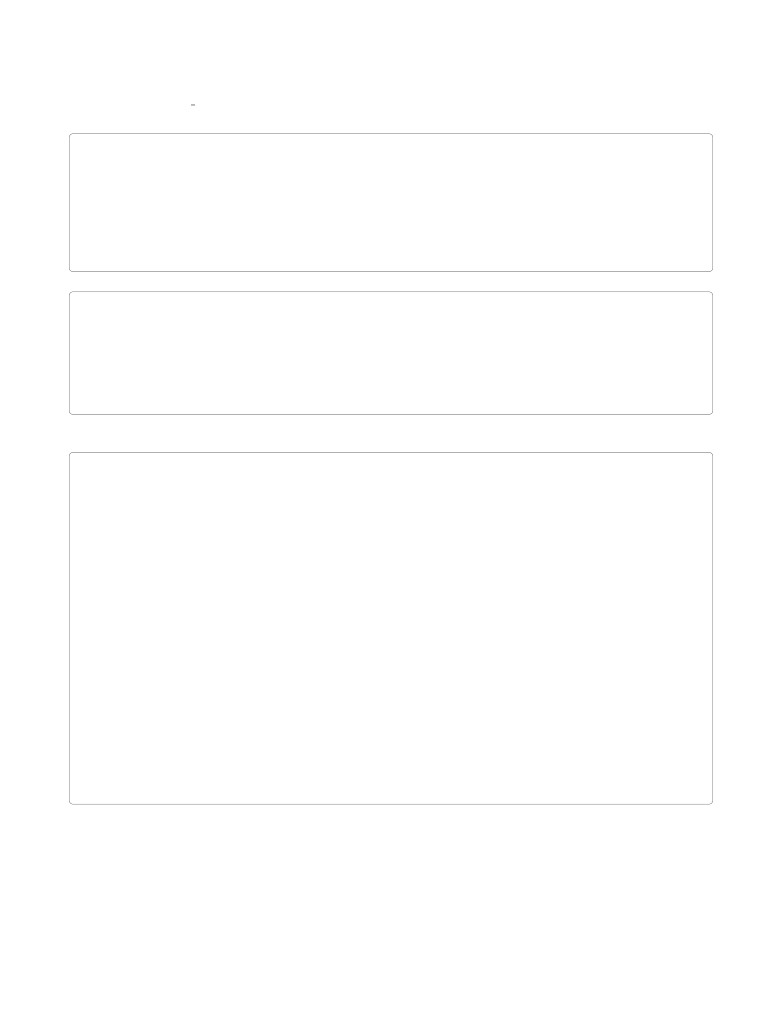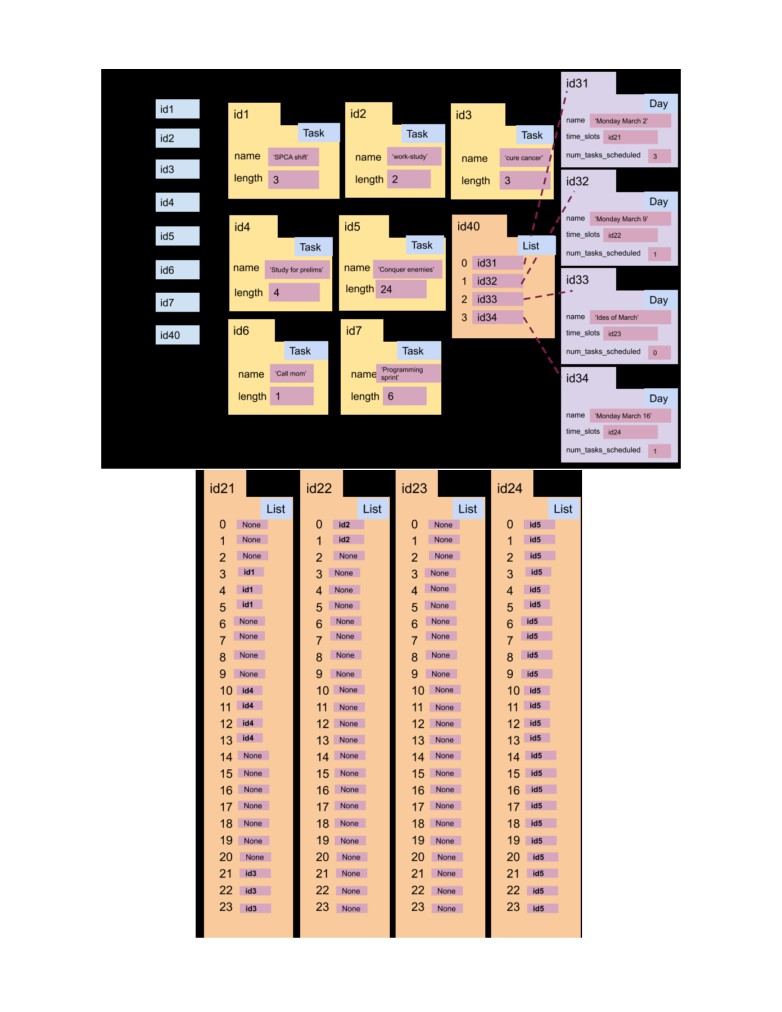CS 1110 Spring 2020, Assignment 3: Tre1110
Updates:
The assignment itself, with updates marked in orange, begins on the next page. On this “page 0”, we also
document the time, location, and nature of the updates, in reverse chronological order,
• Monday Mar 2, 11:30pm:
- Explanation for how to handle grouping over this two-part assignment (pg 3, pg 9)
- Clarification of spec for space available (pg 6)
- Added Section 5.5.1 “Batch” testing allowed to test add task (pg 8)
- (Extremely minor) Rationalized number in Section 6 (pg 9)
CS 1110 Spring 2020, Assignment 3: Tre1110∗
1
Motivation: Get things done!
To-do lists. Surely you’ve got one, and here we are adding to something to it. But this assignment revolves around
an effective strategy for dealing with to-do items: put your tasks on your calendar!
Contents
1
Motivation: Get things done!
2
2
Rules (all the same as for previous assignment)
2
2.1
You need to re-group (so to speak) on CMS, regardless of prior groupings
2
2.2
(Dis-)allowed collaborations and documentation requirements
2
3
Python You Are NOT Allowed To Use In This Assignment
3
4
Due dates
3
5
Task
3
5.1
Overview
3
5.2
Classes Task and Day
5
5.3
Running example
5
5.4
Specifications For The Functions To Write
6
5.5
Writing Test Cases — due Sat Mar 7
7
5.5.1
“Batch” testing allowed for test add task
8
5.6
Writing Function Bodies — due Sun Mar 8
8
5.7
Grand Finale
9
6
Pre-Submission Checklist and What to Submit
9
7
Advice
9
7.1
Debugging
9
7.2
Navigating complex files
9
2
Rules (all the same as for previous assignment)
There is no revise-and-resubmit for this or any subsequent assignment unless otherwise noted.
2.1
You need to re-group (so to speak) on CMS, regardless of prior groupings
You may work alone or with just one other person, who can be someone you’ve grouped with before in CS1110, or a different
person.
If you are partnering, regardless of whether you were grouped in a previous assignment, the two of you must still form a
new group specifically for this assignment on CMS before submitting.1
2.2
(Dis-)allowed collaborations and documentation requirements
means you and, if there is one, your one CMS-registered group partner,
1. Never look at, access or possess any portion of another group’s work in any form.
2. Never show or share any portion of your work in any form to anyone except a member of the course staff.
∗Authors: Lillian Lee, Rhea Bansal, Kevin Cook, Will Xiao.
1This links your submission “portals”.
2
3. Never request solutions from outside sources; for example, on online services like StackOverflow.
4. DO specifically acknowledge by name all help you received, whether or not it was “legal” according to (1)-(3).
3
Python You Are NOT Allowed To Use In This Assignment
See Section 5.1.
4
Due dates
These deadlines were chosen to:
• strongly encourage you to write test cases before writing function bodies — we swear, this practice makes you
a better programmer — and
• allow us to release solutions on Monday March 9, before the prelim on Tuesday March 10.
We’ve broken this homework into two parts, so there are two associated “assignments” on CMS.
(a)
take effect.
(b)
By 2pm on Sat Mar 7, submit whatever you have done at that point on a3 todo test.py to CMS for Assignment
(c)
By 11:59pm on Sat Mar 7, make your final submission of file a3 todo test.py to Assignment A3tests, again
following the aforementioned steps 1-3.
(d)
By 2pm on Sun Mar 8, submit whatever you have done at that point on a3 todo.py to CMS for Assignment
A3fns, again following the aforementioned steps 1-3. It is OK if you haven’t finished working on it yet. If you
grouped for A3tests: The staff will manually group you on A3fns with your A3tests partner after all the
A3fns submissions are in. This means you will not be able to see what your partner submitted on CMS until
after the staff does the behind-the-scenes grouping. The latest of the submissions made by you and/or your
partner will end up being the submission for your group, and it is OK if only one of you ever ends up submitting
files; but you should coordinate with your partner to make sure one of you doesn’t make a submission that ends
up overwriting the other’s in a way that wasn’t intended! If you didn’t group for A3tests: you shouldn’t
work with someone for A3fns.
(e)
By 11:59pm on Sun Mar 8, make your final submission of a3 todo.py to Assignment A3fns, again following
the aforementioned steps 1-3.
5
Task
5.1
Overview
One goal of this assignment is to provide you more experience with larger code bodies and more complexly inter-
relating object structures. The most difficult part of this assignment will probably not be the writing of the functions,
but understanding the structure of the classes and how to write testcases for functions dealing with these classes.
A second major goal of this assignment is practice with for-loops, since for-loops are a great way to get things
done. This goal implies that, for each of the functions we have you implement, we reserve the right to assign no
credit for code that isn’t fundamentally based on an explicit for-loop, or uses a for-loop in the way we ask for, even
if the code fulfills the specification. Good references on for-loops besides lecture and the text: some examples from
Spring 2018 ; the completed for-loops we’ve given you in the A3 code.3
2The 2pm checkpoints provide you a chance to alert us if any problems arise. Since you’ve been warned to submit early, do not expect
that we will accept work that doesn’t make it onto CMS on time, for whatever reason. There are no so-called “slipdays” and there is no
“you get to submit late at the price of a late penalty” policy. Of course, if some special circumstances arise, contact the instructor(s)
immediately.
might not be worth trying to understand the setups in those A3s.
3
As an application of for-loops, the assignment files (contained in this zip file ) give you the skeleton for writing and
testing a program that helps you schedule your tasks. Here’s a sample interaction for a completed implementation:
llee A3 > python a3_app.py
Welcome to the Tre1110 planner!
Here, you can plan out the next week (from Sunday - Saturday).
Type 'print <day>' to view your schedule for that day,
or 'print all'
to view your whole week at once.
To add a task to the planner, type 'add task'.
Type 'q' to quit.
What would you like to do?
> add task
What is the name of your task?
> finish the assignment writeup
How many hours will your task take (integers please)?
> 1
What day would you like to add this task to?
> Monday
What hour will your task start (24 hour time please)?
> 1
Successfully added!
What would you like to do now? (add task, print <day>, print all, q)
> add task
What is the name of your task?
> answer DUS emails
How many hours will your task take (integers please)?
> 2
What day would you like to add this task to?
> Monday
What hour will your task start (24 hour time please)?
> 1
Sorry, couldn't add it to your schedule at that time!
What would you like to do now? (add task, print <day>, print all, q)
> add task
What is the name of your task?
> answer DUS emails
How many hours will your task take (integers please)?
> 2
What day would you like to add this task to?
> Monday
What hour will your task start (24 hour time please)?
> 14
Successfully added!
What would you like to do now? (add task, print <day>, print all, q)
> add task
What is the name of your task?
> meet with chair
How many hours will your task take (integers please)?
> 1
What day would you like to add this task to?
> Tuesday
What hour will your task start (24 hour time please)?
> 13
Successfully added!
4
What would you like to do now? (add task, print <day>, print all, q)
> print all
Sunday:
No events scheduled.
Monday:
1:00-2:00 finish the assignment writeup
14:00-16:00 answer DUS emails
Tuesday:
13:00-14:00 meet with chair
Wednesday:
No events scheduled.
Thursday:
No events scheduled.
Friday:
No events scheduled.
Saturday:
No events scheduled.
What would you like to do now? (add task, print <day>, print all, q)
> q
Goodbye and good luck getting all your tasks done!
5.2
Classes Task and Day
File a3 classes.py defines classes Task and Day. We haven’t discussed classes in detail yet, but here’s all you need
to know about these two classes.
Task objects have two atrributes, a name and a length. A call Task("shop at Wegmans", 1) creates a Task
with name “go to Wegmans” that takes 1 hour to complete.
Day objects have three attributes, a name; a 24-item list time slots, one item for each hour of the day; and
num tasks scheduled, which should be the number of tasks scheduled for that day. A call Day("My birthday") cre-
ates a Day with name “My birthday”, nothing (yet) scheduled for any of its 24 hours, and attribute num tasks scheduled
set to 0.
More information is available in the docstrings of the two class definitions.
5.3
Running example
Figure 1 shows an example of how these objects might be used.
In global space, you see 5 predefined Tasks whose identifiers have been stored in variables predef1 through
predef5; these have already been scheduled, as described later in this section. There are also two Tasks waiting to
be scheduled, todo call and todo hack. Finally, the variable DAY POOL holds a list of Days during which Tasks can
be scheduled.
DAY POOL[0] is the Day with name “Monday March 2”, which has three tasks already scheduled for it. Looking
at DAY POOL[0].time slots, which is a list of 24 hours, we see that the Task with id id1 has been scheduled for the
hours 3, 4, and 5; this Task has the name “SPCA shift”. Hours 10, 11, 12, and 13 are devoted to the Task with id
id4, named “Study for prelims”. Finally, hours 21, 22, and 23 are filled by the Task with id id3, “cure cancer”. All
the other entries in this list are None, meaning that nothing has been scheduled there.
You should similarly be able to see that DAY POOL[1] “Monday March 9” has the Task “work-study” (id2)
from midnight to 2am but is otherwise free; DAY POOL[2] “Ides of March” is (ominously?) completely free, and
DAY POOL[3] “Monday March 16” is completely occupied with Task id5 “Conquer enemies”.
The Tasks todo call and todo hack have not yet been slotted into DAY POOL; your task4 is to complete the
functions in file a3 todo.py to make it easy to add Tasks to a specific Day.
4That wasn’t intentional!
5
5.4
Specifications For The Functions To Write
The name sirialize days is meant to evoke Siri, as in “Siri, tell me what I have scheduled in the next couple of
days.”
def sirialize_days(day_list):
"""
Prints out the tasks for each day in day_list, first by day in the order
in which they appear in day_list, and then chronologically within each day.
Parameter day_list: The list of days to print data out for.
Precondition: day_list is non-empty list of Day objects (no None objects).
"""
def num_hours_busy(day):
"""
Returns: the number of hours that are busy in Day `day`.
Parameter day: the Day to check.
Precondition: day is a Day object.
"""
Addition to spec below: ”and False otherwise”
def space_available(slots, start_time, end_time):
"""
Returns: True if there is space available to schedule an event in `slots`
from `start_time` (inclusive) to `end_time` (exclusive) and False otherwise}.
So, `space_available(agenda, 14, 16)` queries whether 2-4 pm is available,
and it doesn't matter is something is scheduled at 4pm.
There is space available if all the elements of slots starting from
`start_time` (inclusive) to `end_time` (exclusive) are all None.
Parameter slots: The list of timeslots to check.
Precondition: slots is a list of length 24, each element of which is either
a Task object or None.
Parameter start_time: The starting time to check from, inclusive.
Precondition: start_time is an int, and a valid index into `slots`
(0 <= start_time < 24), and start_time < end_time.
Parameter end_time: The ending time to check to, exclusive.
Precondition: end_time is an int for a valid ending time
(0 <= end_time <= 24), and start_time < end_time.
"""
6
def
add_task(day, task, start_time):
"""
Returns: True if Task `task` is added to Day `day` at time `start_time`
successfully, False otherwise.
This function attempts to add the given task to the given day and time.
If the specified timeslot is free, then the `time_slots` attribute of the
Day object is modified to reflect that the task has been added, meaning that
each hour timeslot that this task occupies must be filled in the list.
This means that if a task takes multiple hours, there must be multiple
references to that Task object in the timeslot list, one for each hour
the task takes.
If the task can successfully be added, this function also increments the
num_tasks_scheduled attribute of Day `day` by 1 to reflect this new task.
A task cannot be added to the Day object if any Task that is currently
scheduled for that day would overlap with `task` if it were added at
`start_time`. For example, adding a 3 hour long task at 2:00 should fail if
there are any tasks scheduled between the hours of 2:00 and 5:00.
A task also cannot be added if scheduling the task at the given
time would require rolling over to the next day to finish. As an example,
trying to schedule a task that takes two hours to complete at 23:00
(i.e. start_time == 23) should fail.
If the given task cannot be added, this function returns False and does
not modify anything.
Parameter day: The Day object to attempt to add Task `task` to.
Precondition: day is a Day object.
Parameter task: The Task object to add to Day `day`.
Precondition: task is a Task object.
Parameter start_time: The hour to start this task at.
Precondition: start_time is an int , and 0 <= start_time < 24.
"""
5.5
Writing Test Cases — due Sat Mar 7
From reading the specifications above, we hope you’ll have a sense of some situations that need testing: for ex-
ample, does num hours busy return the right answer for a completely empty or a completely full day? And does
space available? What if someone tries to add a Task to a time slot that is already occupied?
To make writing up test cases easier for you, we provided code you can use in a3 todo test.py that sets up some
of the situation depicted in Figure 1, although it doesn’t put any of the Tasks into DAY POOL:
7
import a3_classes
# globals setting things up somewhat like assignment diagram
predef1
= a3_classes.Task("SPCA shift", 3)
predef2
= a3_classes.Task("work-study", 2)
predef3
= a3_classes.Task("cure cancer", 3)
predef4
= a3_classes.Task("Study for prelims", 4)
predef5
= a3_classes.Task("Conquer enemies", 24)
todo_call = a3_classes.Task("Call mom", 1)
todo_hack = a3_classes.Task("Programming sprint", 6)
DAY_POOL = [a3_classes.Day("Monday March 2"),
# all time_slots are None
a3_classes.Day("Monday March 9"),
# all time_slots are None
a3_classes.Day("Ides of March"),
# all time_slots are None
a3_classes.Day("Monday March 16")
# all time_slots are None
]
You’ll also see in test sirialize days how you can add Tasks to a Day without having written add task yet:
day = a3_classes.Day("Day in the City")
task_driveout = a3_classes.Task("Drive to NYC", 4)
day.time_slots[4] = task_driveout; day.time_slots[5] = task_driveout
day.time_slots[6] = task_driveout; day.time_slots[7] = task_driveout
In addition, we’ve also provided some testing code for you for each of your functions. You do not need to add
anything to test sirialize days, but you do need to add test cases to the other test functions we’ve given you.
Follow the directions given as comments in the code.
5.5.1
“Batch” testing allowed for test add task
Given the timeframe of this assignment relative to the upcoming prelim, we’ve decided that for just the test function
test add task, you may save time by “batching” testcases rather than interleaving them, even though this is a less
thorough form of testing.
The skeleton we provided you does this “batching”, as follows. On the left in the figure below, we illustrate
“batched” testing; on the right, “interleaved”, and better structure.
batched
interleaved
action1
action1
action2
test1 of expectations
action3
action2
action4
test2 of expectations
action5
action3
Test that everything is as expected
test3
after the 5 actions are performed.
action4
test4
action5 test5
In the “batched” case, you only have to write one block of testing-expectations code. But, if, say action1 made a
mistake and action3 made a mistake, but the two mistakes cancelled out, the “batched” testing wouldn’t catch this.
So, interleaved testing is what you should do in most situations! But in the interests of time, you are permitted
to submit batched testing code for A3.
Do note that this leniency towards what test code you submit does not relieve you of the responsibility for making
sure your function bodies are actually correct according to our testing.
5.6
Writing Function Bodies — due Sun Mar 8
Follow the directions given as comments in a3 todo.py.
8
5.7
Grand Finale
You needn’t turn in anything for this part, but once you’ve got your code thoroughly tested and working, if you’d like
to see your code in action, see if you can reproduce the interaction depicted in reproduce the interaction in Section
5.1, by running python a3 app.py.
6
Pre-Submission Checklist and What to Submit
Files to submit: a3 todo test.py for Assignment A3tests, a3 todo.py for Assignment A3fns.
Before submitting, ensure your code obeys the following.5
1. Lines are short enough (˜80 characters) that horizontal scrolling is not necessary.
2. You have indented with spaces, not tabs
3. Functions are separated from each other by at least two blank lines.
4. You have removed any debugging print statements.
5. You have removed all pass statements.
6. You have removed “instruction” comments, such as “# IMPLEMENT THIS FUNCTION”.
7. If you added any helper functions, these have good docstring specifications. In your specification docstrings,
include descriptions of your key test-cases.6
Make sure the following are all true before you submit.
8.
You’ve changed the header comments in all files to list the entire set of people and sources that contributed to
the code.
9.
You (and your partner) have included your NetIDs in the header of all files.
10.
The date in the header comments has been changed to when the files were last edited.
11.
invitations.
12.
(reminder) If working with a partner, you have grouped on CMS in A3tests. (One has invited on CMS, and
one has accepted on CMS.) The staff will group A3tests partners in A3fns after the deadlines have passed.
7
Advice
7.1
Debugging
1.
Many bugs are caused by unintentionally changing the semantics of a variable. Pick informative variable names
and/or comment what your intents are. Make sure you update variable values correctly when the situation
changes.
2.
Section 13.10 of the text (“...especially if you are working on a hard bug”) is good advice.
3.
Only implement a little bit at a time and test incessantly. Add temporary print statement to check your partial
progress as necessary. You don’t want an uncaught bug early one messing up a lot of things downstream.
4.
You can use Python Tutor to visualize what your code is doing.
7.2
Navigating complex files
1.
Atom lets you “fold up” parts of code, such as function bodies, to temporarily hide them. Look for a little
down-pointing arrow-head in the lefthand ”gutter” of a code window, and click on it.
5These requirements up speed up the process of reading/grading hundreds of files.
6This is a workaround for the fact that you’ll be submitting your testcase files for the required A3 functions earlier, and might write
your helpers afterwards.
9
Figure 1: Example set of days and tasks.
10









